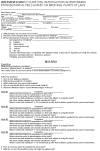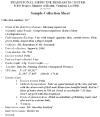An ethnobotanical survey of medicinal plants of Laos toward the discovery of bioactive compounds as potential candidates for pharmaceutical development
- PMID: 22136442
- PMCID: PMC3534868
- DOI: 10.3109/13880209.2011.619700
An ethnobotanical survey of medicinal plants of Laos toward the discovery of bioactive compounds as potential candidates for pharmaceutical development
Erratum in
- Pharm Biol. 2012 Jun;50(6):799
Abstract
Context: An ethnobotany-based approach in the selection of raw plant materials to study was implemented.
Objective: To acquire raw plant materials using ethnobotanical field interviews as starting point to discover new bioactive compounds from medicinal plants of the Lao People's Democratic Republic.
Methods: Using semi-structured field interviews with healers in the Lao PDR, plant samples were collected, extracted, and bio-assayed to detect bioactivity against cancer, HIV/AIDS, TB, malaria. Plant species demonstrating activity were recollected and the extracts subjected to a bioassay-guided isolation protocol to isolate and identify the active compounds.
Results: Field interviews with 118 healers in 15 of 17 provinces of Lao PDR yielded 753 collections (573 species) with 955 plant samples. Of these 955, 50 extracts demonstrated activity in the anticancer, 10 in the anti-HIV, 30 in the anti-TB, and 52 in the antimalarial assay. Recollection of actives followed by bioassay-guided isolation processes yielded a series of new and known in vitro-active anticancer and antimalarial compounds from 5 species.
Discussion: Laos has a rich biodiversity, harboring an estimated 8000-11,000 species of plants. In a country highly dependent on traditional medicine for its primary health care, this rich plant diversity serves as a major source of their medication.
Conclusions: Ethnobotanical survey has demonstrated the richness of plant-based traditional medicine of Lao PDR, taxonomically and therapeutically. Biological assays of extracts of half of the 955 samples followed by in-depth studies of a number of actives have yielded a series of new bioactive compounds against the diseases of cancer and malaria.
Conflict of interest statement
There are no conflicts of interest. The authors alone are responsible for the content and writing of the paper.
Figures







Similar articles
-
Ethnobotanical approach versus random approach in the search for new bioactive compounds: support of a hypothesis.Pharm Biol. 2012 Jan;50(1):30-41. doi: 10.3109/13880209.2011.634424. Pharm Biol. 2012. PMID: 22196581 Free PMC article.
-
Cameroonian medicinal plants: a bioactivity versus ethnobotanical survey and chemotaxonomic classification.BMC Complement Altern Med. 2013 Jun 26;13:147. doi: 10.1186/1472-6882-13-147. BMC Complement Altern Med. 2013. PMID: 23802859 Free PMC article.
-
Forest Fevers: traditional treatment of malaria in the southern lowlands of Laos.J Ethnopharmacol. 2020 Mar 1;249:112187. doi: 10.1016/j.jep.2019.112187. Epub 2019 Aug 30. J Ethnopharmacol. 2020. PMID: 31476439
-
An overview on ethnobotanico-pharmacological studies carried out in Morocco, from 1991 to 2015: Systematic review (part 1).J Ethnopharmacol. 2021 Mar 1;267:113200. doi: 10.1016/j.jep.2020.113200. Epub 2020 Aug 1. J Ethnopharmacol. 2021. PMID: 32750461
-
A review on traditionally used South African medicinal plants, their secondary metabolites and their potential development into anticancer agents.J Ethnopharmacol. 2020 Oct 28;261:113101. doi: 10.1016/j.jep.2020.113101. Epub 2020 Jun 17. J Ethnopharmacol. 2020. PMID: 32562876 Review.
Cited by
-
Bioactive Molecules Derived from Plants in Managing Dengue Vector Aedes aegypti (Linn.).Molecules. 2023 Mar 5;28(5):2386. doi: 10.3390/molecules28052386. Molecules. 2023. PMID: 36903635 Free PMC article. Review.
-
Discovery of Bioactive Compounds by the UIC-ICBG Drug Discovery Program in the 18 Years Since 1998.Molecules. 2016 Oct 31;21(11):1448. doi: 10.3390/molecules21111448. Molecules. 2016. PMID: 27809237 Free PMC article. Review.
-
Revisiting the linkage between ethnomedical use and development of new medicines: A novel plant collection strategy towards the discovery of anticancer agents.J Med Plant Res. 2017 Oct;11(40):621-634. doi: 10.5897/jmpr2017.6485. Epub 2017 Oct 25. J Med Plant Res. 2017. PMID: 29152156 Free PMC article.
-
Wild food plants and fungi sold in the markets of Luang Prabang, Lao PDR.J Ethnobiol Ethnomed. 2021 Jan 26;17(1):6. doi: 10.1186/s13002-020-00423-y. J Ethnobiol Ethnomed. 2021. PMID: 33499871 Free PMC article.
-
Flavonoids of Chromolaena odorata (L.) R.M.King & H.Rob. as potential leads for treatment against tuberculosis.S Afr J Bot. 2023 Jul;158:158-165. doi: 10.1016/j.sajb.2023.05.002. Epub 2023 May 13. S Afr J Bot. 2023. PMID: 37206481 Free PMC article.
References
-
- Central Intelligence Agency. [Accessed on 27 June 2011];East & Southeast Asia: Laos. 2011 Available online at https://www.cia.gov/library/publications/the-world-factbook/geos/la.html.
-
- Chape S. Biodiversity Conservation, Protected Areas and the Development Imperative in Lao PDR: Forging the Links. Vientiane: IUCN The World Conservation Union; 1996.
-
- Chazee L. The Peoples of Laos: Rural and Ethnic Diversities. Bangkok: White Lotus Press; 1999.
-
- Conservation International. [Accessed on 2 July 2011];Indo-Burma Biodiversity Hotspots. 2011 Available online at http://www.biodiversityhotspots.org/xp/hotspots/indo_burma/Pages/default....
Publication types
MeSH terms
Substances
Grants and funding
LinkOut - more resources
Full Text Sources
Other Literature Sources
